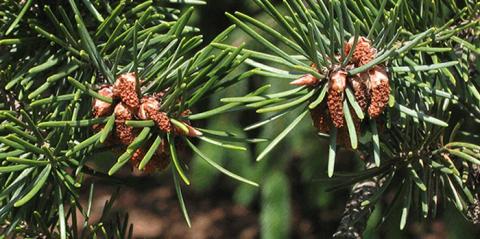Tree Pollen – Nothing to Sneeze At
April 29, 2014
Have you recently noticed a layer of fine yellow dust on your car or picnic table that becomes slimy when wet and crusty when dry? This is probably tree pollen.
Early spring in Oregon is our first major pollen season. Conifer trees and some hardwood trees release their pollen now, followed in a few weeks by grasses and in mid-summer by weeds.
In spite of my allergic reaction to it, I think of tree pollen as a marvel. When we first learn about plant sex, we learn about the birds and the bees. These pollinators gather nectar from flowers and in the process get covered with pollen that they inadvertently take to the next flower, where they seek nectar and leave pollen there.
Pollinator-pollination is common in some species of forest trees like maples and cherries, but wind-pollination is much more common. This is the mechanism used in all of our conifer trees such as Douglas-fir and the various pine species.
Conifer means “cone-bearer,” and both the male and female flowers are some sort of cone. The male cones or strobili are pretty obvious in the late winter and early spring. They are generally egg-shaped, range in color from yellow to brownish-red, and are about ¾-inch long and borne in clusters near the end of the branch. The strobili open in March to May, depending on elevation and latitude, and shower the world with millions of microscopic pollen grains. When you shake a branch during this period you’ll often see a yellow cloud of pollen.
A very small number of these pollen grains strike gold and land in a female cone. The female cones are about 1 inch in diameter. They are usually borne singly near the tips of branches, are often reddish, and point upward to catch falling pollen. They open to receive pollen when conditions are just right. After being pollinated, the cones close and gradually change color to green and eventually brown. They also gradually turn downward to be good seed releasers.
Each seed produced in a female cone was pollinated by a single pollen grain. When you consider the odds of a grain of pollen cast to the wind landing in a female cone, you can see why conifers need to make so much pollen.
So next time you see a cloud of conifer pollen, consider the marvel before you sneeze. That is, if you can see through your allergy-swollen eyes. Gesundheit!
For the forest,
Mike Cloughesy
Director of Forestry
